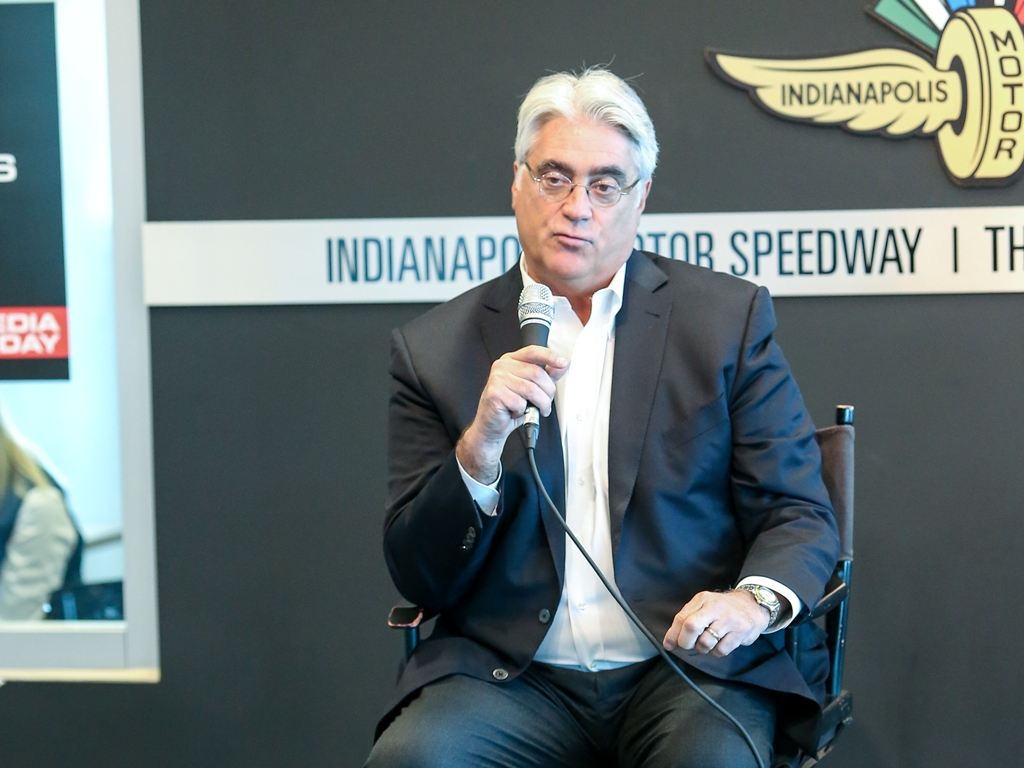
Photo Credit: IndyCar
The 2017 IndyCar Season Schedule was released on August 25 and it looks to be an exciting season coming as there is a good balance between the different types of tracks the cars will race on with six ovals, six road courses and five street courses. As a result, Mark Miles is hoping the balance he has laid down is the foundation to grow the sport.
“You know, I had the opportunity to fly here to St. Louis this morning with these three gentlemen with me, who will have a chance to say something, and on the way I showed the calendar to Josef Newgarden, he looked at it for about a second, we’re thinking 16 plus one because the 16 races which we’re coming back year over year and the addition of Gateway is kind of one way to think about it,” Miles added. “Turning a phrase, as he’s prone to do, he instantly says, oh, 17 in ’17, which may become the new handle on the race. But the foundation of it and the priority for us is to the greatest extent possible have continuity from year over year with our races and date equity to the greatest extent possible and to just grow that base carefully, and I think the 16 plus one or 17 for ’17 demonstrates that.”
In 2017, IndyCar will be coming back to Gateway Motorsports Park and they signed a formal contract extension with Watkins Glen International Raceway. Miles states he is enthused about the addition of Gateway as well as being able to lock WGI on the schedule for a few years.
“All the components seem to be coming together from an event perspective, and probably better that the drivers than I speak about the track, but Curtis Francois bought the track I think in 2012 or so, repaved it, has done a terrific job in making improvements, so those of our fans who think of it from many years ago will be delighted with what they see. It’s a terrific place, and it was designed for IndyCar racing. It’ll be a compelling race for sure, another short oval we’re pleased to add,” Miles said. “So that’s terrific. And Watkins Glen came to us and was added to the Verizon IndyCar Series with very little notice this year. We’re looking forward to being there in less than a couple weeks and expect a great event. So to be able to extent them even before the first race was part of the plan to lock in the great races that we have. I think it’s fair to say that all of the existing races have contracts for more than 2017, so I expect they’ll be back not just for ’17 but in the future, as well.”
Miles felt it was important to have the schedule out before the end of the season. In the past IndyCar fans would have to wait a few months after a season ended before the new schedule was out.
“Also for the tracks; here happily we are in August, and we’re announcing a schedule, and they have a year to prepare,” Miles quoted. “I think every promoter would relish, as we have in Indianapolis frankly, the opportunity to be selling next year’s tickets at this year’s race. In order to do that, we’ve just got to get ahead of the game. So for the promoters, I think for fans who will travel, for our broadcasters, for our teams as they prepare, this plus for them the test schedule that will come out before long, the sooner the better, and we’re delighted. We kind of put the stake in the ground that we’d get this out in August, and I think we’re still in August, so we’re delighted to have met the goal.”
Miles is hoping in the future he can expand the series further. He is already working on the 2018 Schedule and trying to get new tracks added on to the current tracks.
” Our philosophy about growth is careful, managed growth where we add to fill in gaps on the schedule, and those to me looking at next year, we still believe there may be an international opportunity at the very beginning of the year to be abroad, and that will do lots of things for us if we can find a great opportunity for ’18 in February,” Miles added. “And then there may be one more opportunity to add during what we currently have kind of staked out as the heart of the Verizon IndyCar Series schedule in North America. So I don’t see it expanding in the next year or so in any major way, but given the demand and the interest, I think we’ll have good choices and can be quite careful.
“We think about all the factors from the balance we want to try to keep in terms of the type of racing, which we’ve already talked about, in terms of urban versus more park-like as we have now in so many of our races, Midwest versus other regions of the country. We’re pretty Midwest based, and I think there’s an appetite west, northwest, east or southeast in this country, urban versus more rural. So all those things go into it, and I think we just look at the options on a case-by-case basis and try to make the best calls.
“Fundamentally, the most important thing, irrespective of what kind of track and where it is in the country or the world, we want races like we have for the most part where the race is an event that captures the imagination of the community and more and more people come every year, which makes for a great event, young people, traditional fans want to be part of on side, and makes for great television, because not just what happens on the track is compelling but there’s the vibe that’s communicated out for television viewers, as well.”




